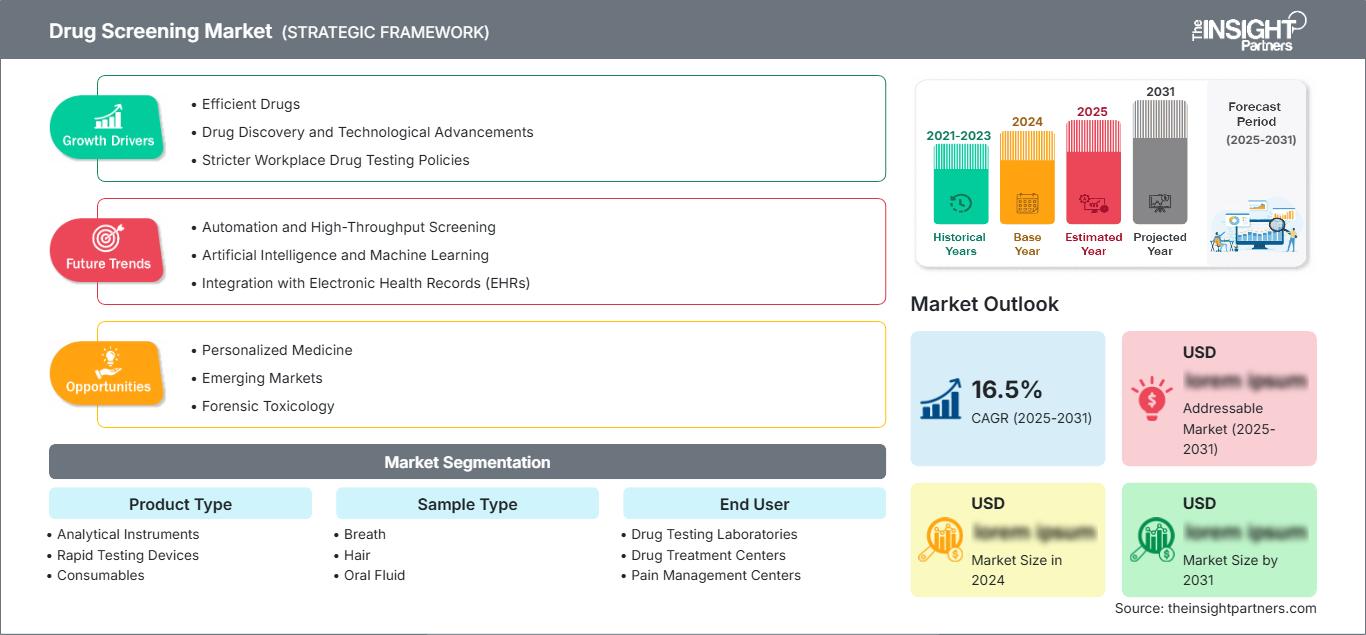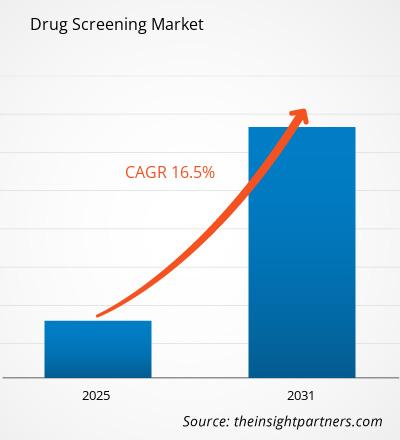Si prevede che il mercato dello screening antidroga raggiungerà i 22,37 miliardi di dollari entro il 2031. Si prevede che il mercato registrerà un CAGR dell'11,7% nel periodo 2025-2031.
Il rapporto è suddiviso in tre sezioni: Tipo di prodotto (strumenti analitici, dispositivi per test rapidi, materiali di consumo), Tipo di campione (alito, capelli, fluido orale, urina, altri) e Utente finale (laboratori di test antidroga, centri di trattamento della droga, centri per la gestione del dolore, sistemi di giustizia penale e forze dell'ordine, ospedali, altri)
Scopo del rapporto
Il rapporto Drug Screening Market di The Insight Partners mira a descrivere il panorama attuale e la crescita futura, i principali fattori trainanti, le sfide e le opportunità. Ciò fornirà spunti a vari stakeholder aziendali, come:
- Fornitori/produttori di tecnologia: per comprendere le dinamiche di mercato in evoluzione e conoscere le potenziali opportunità di crescita, consentendo loro di prendere decisioni strategiche informate.
- Investitori: per condurre un'analisi completa delle tendenze in merito al tasso di crescita del mercato, alle proiezioni finanziarie del mercato e alle opportunità esistenti lungo la catena del valore.
- Organismi di regolamentazione: per regolamentare le politiche e le attività di controllo nel mercato con l'obiettivo di ridurre al minimo gli abusi, preservare la fiducia degli investitori e sostenere l'integrità e la stabilità del mercato.
Segmentazione del mercato dello screening antidroga Tipo di prodotto
- Strumenti analitici
- Dispositivi per test rapidi
- Materiali di consumo
Tipo di campione
- Respiro
- Capelli
- Fluido orale
- Urina
- Altri
Utente finale
- Laboratori di test antidroga
- Centri di trattamento farmacologico
- Centri di gestione del dolore
- Sistemi di giustizia penale e forze dell'ordine
- Ospedali
- Altri
Geografia
- Nord America
- Europa
- Asia-Pacifico
- Sud e Centro America
- Medio Oriente e Africa
Potrai personalizzare gratuitamente qualsiasi rapporto, comprese parti di questo rapporto, o analisi a livello di paese, pacchetto dati Excel, oltre a usufruire di grandi offerte e sconti per start-up e università
Mercato dello screening antidroga: Approfondimenti strategici

-
Ottieni le principali tendenze chiave del mercato di questo rapporto.Questo campione GRATUITO includerà l'analisi dei dati, che vanno dalle tendenze di mercato alle stime e alle previsioni.
Fattori di crescita del mercato dello screening farmacologico
- Farmaci efficienti: nuovi farmaci con elevata efficacia e sicurezza determinano una domanda crescente, poiché malattie croniche come diabete, malattie cardiovascolari e cancro sono in aumento. Identificati potenziali candidati farmaci e valutati per efficacia e sicurezza, lo screening farmacologico ha un ruolo estremamente importante da svolgere. Si registra inoltre un enorme aumento dei costi sanitari e la richiesta di una medicina più personalizzata rappresenta un'opportunità senza precedenti.
- Scoperta di farmaci e progressi tecnologici: il processo di scoperta di farmaci è ora rapido e accurato grazie al progresso tecnologico, incluso il settore dello screening ad alto rendimento e dell'intelligenza artificiale. La crescente importanza del riutilizzo dei farmaci, che scopre nuovi usi per farmaci già disponibili, stimola anche il mercato dello screening farmacologico. Infine, ma non meno importante, le pressioni normative garantiscono la sicurezza e l'efficacia dei farmaci; è necessario elaborare rigorosi protocolli di screening farmacologico per garantire standard elevati.
- Politiche più severe sui test antidroga sul posto di lavoro: molti settori hanno implementato rigide politiche sui test antidroga per garantire un ambiente di lavoro sicuro e produttivo.
Tendenze future del mercato dello screening antidroga
- Automazione e screening ad alta produttività: l'adozione di tecnologie di automazione e screening ad alta produttività accelererà la scoperta e lo sviluppo di farmaci aumentando la produttività e riducendo i costi.
- Intelligenza artificiale e apprendimento automatico: l'integrazione di algoritmi di intelligenza artificiale e apprendimento automatico consentirà analisi avanzate dei dati, modelli predittivi e l'identificazione di nuovi target farmacologici.
- Integrazione con le cartelle cliniche elettroniche (EHR): l'integrazione dei risultati dello screening farmacologico con le EHR semplificherà l'assistenza ai pazienti e faciliterà l'analisi dei dati.
Opportunità di mercato per lo screening farmacologico
- Medicina personalizzata: lo sviluppo di approcci di medicina personalizzata, adattati alle esigenze individuali dei pazienti, richiederà tecniche avanzate di screening farmacologico per identificare opzioni terapeutiche idonee.
- Mercati emergenti: i paesi in via di sviluppo con infrastrutture sanitarie in crescita e una spesa sanitaria in aumento offrono significative opportunità di crescita per il mercato dello screening farmacologico.
- Tossicologia forense: assistenza nelle indagini penali e nei procedimenti legali mediante l'analisi di campioni biologici per farmaci e tossine.
Le tendenze regionali e i fattori che influenzano il mercato dello screening farmacologico durante il periodo di previsione sono stati ampiamente spiegati dagli analisti di The Insight Partners. Questa sezione illustra anche i segmenti di mercato e la geografia della gestione delle malattie del ritmo cardiaco in Nord America, Europa, Asia-Pacifico, Medio Oriente e Africa, America meridionale e centrale.
Ambito del rapporto di mercato sullo screening dei farmaci
| Attributo del rapporto | Dettagli |
|---|---|
| Dimensioni del mercato in 2024 | US$ XX Billion |
| Dimensioni del mercato per 2031 | US$ 22.37 Billion |
| CAGR globale (2025 - 2031) | 11.7% |
| Dati storici | 2021-2023 |
| Periodo di previsione | 2025-2031 |
| Segmenti coperti |
By Tipo di prodotto
|
| Regioni e paesi coperti |
Nord America
|
| Leader di mercato e profili aziendali chiave |
|
Densità degli operatori del mercato dello screening farmacologico: comprendere il suo impatto sulle dinamiche aziendali
Il mercato dello screening antidroga è in rapida crescita, trainato dalla crescente domanda degli utenti finali, dovuta a fattori quali l'evoluzione delle preferenze dei consumatori, i progressi tecnologici e una maggiore consapevolezza dei benefici del prodotto. Con l'aumento della domanda, le aziende stanno ampliando la propria offerta, innovando per soddisfare le esigenze dei consumatori e sfruttando le tendenze emergenti, alimentando ulteriormente la crescita del mercato.

- Ottieni il Mercato dello screening antidroga Panoramica dei principali attori chiave
Punti di forza
- Copertura completa: il rapporto copre in modo completo l'analisi di prodotti, servizi, tipologie e utenti finali del mercato dello screening antidroga, fornendo un panorama olistico.
- Analisi di esperti: il rapporto è compilato sulla base della conoscenza approfondita di esperti e analisti del settore.
- Informazioni aggiornate: il rapporto garantisce rilevanza aziendale grazie alla sua copertura di informazioni recenti e tendenze dei dati.
- Opzioni di personalizzazione: questo rapporto può essere personalizzato per soddisfare le esigenze specifiche del cliente e adattarsi in modo appropriato alle strategie aziendali.
Il rapporto di ricerca sul mercato dello screening antidroga può, quindi, aiutare a guidare il percorso di decodificazione e comprensione dello scenario del settore e delle prospettive di crescita. Sebbene possano esserci alcune preoccupazioni valide, i vantaggi complessivi di questo rapporto tendono a superare gli svantaggi.
- Analisi storica (2 anni), anno base, previsione (7 anni) con CAGR
- Analisi PEST e SWOT
- Valore/volume delle dimensioni del mercato - Globale, Regionale, Nazionale
- Industria e panorama competitivo
- Set di dati Excel
Report recenti
Rapporti correlati
Testimonianze
Motivo dell'acquisto
- Processo decisionale informato
- Comprensione delle dinamiche di mercato
- Analisi competitiva
- Analisi dei clienti
- Previsioni di mercato
- Mitigazione del rischio
- Pianificazione strategica
- Giustificazione degli investimenti
- Identificazione dei mercati emergenti
- Miglioramento delle strategie di marketing
- Aumento dell'efficienza operativa
- Allineamento alle tendenze normative






















 Ottieni un campione gratuito per - Mercato dello screening antidroga
Ottieni un campione gratuito per - Mercato dello screening antidroga